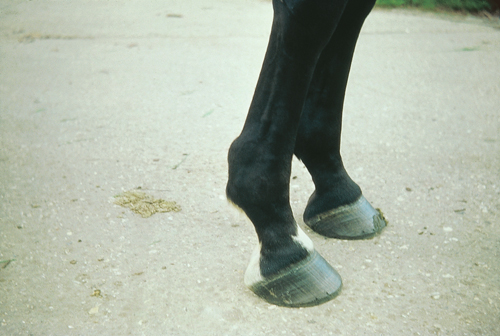Difference between revisions of "Equine Orthopaedics and Rheumatology Q&A 07"
Jump to navigation
Jump to search
| Line 12: | Line 12: | ||
|q1=What abnormal features of the right forelimb can be recognised in the image? | |q1=What abnormal features of the right forelimb can be recognised in the image? | ||
|a1=There is marked distension of the digital sheath on the palmar aspect of the fetlock. The distal end of the swelling has a notched appearance. The horse has a slightly broken back hoof–pastern axis and low heels. | |a1=There is marked distension of the digital sheath on the palmar aspect of the fetlock. The distal end of the swelling has a notched appearance. The horse has a slightly broken back hoof–pastern axis and low heels. | ||
| − | |l1=Palpable Points | + | |l1=Palpable Points - Horse Anatomy#Metacarpophalangeal Joint |
|q2=From the history and clinical signs, what causes of lameness would you consider? | |q2=From the history and clinical signs, what causes of lameness would you consider? | ||
|a2= | |a2= | ||
Latest revision as of 15:33, 13 November 2012
| This question was provided by Manson Publishing as part of the OVAL Project. See more Equine Orthopaedic and Rheumatological questions |
An eight-year-old Thoroughbred gelding presented with a right forelimb lameness, grade 2/5 at the trot, of eight weeks duration. The lameness was insidious in onset, did not improve with rest or exercise, and was the same on any surface.
| Question | Answer | Article | |
| What abnormal features of the right forelimb can be recognised in the image? | There is marked distension of the digital sheath on the palmar aspect of the fetlock. The distal end of the swelling has a notched appearance. The horse has a slightly broken back hoof–pastern axis and low heels.
|
Link to Article | |
| From the history and clinical signs, what causes of lameness would you consider? |
But in view of the poor foot conformation, a foot problem should also be considered as the cause of the lameness, since these digital sheath swellings are not always painful. |
Link to Article | |
| What further tests would you perform to confirm your diagnosis? | Intrasynovial analgesia of the digital sheath will not always abolish the lameness, presumably because of adhesions or the mechanical influence of the constricted annular ligament.
|
Link to Article | |
| How would you treat this case? | Acute cases should be treated with rest, possibly combined with both topical and systemic anti-inflammatory drug therapy. If this fails, an annular ligament desmotomy is indicated.
|
Link to Article | |
